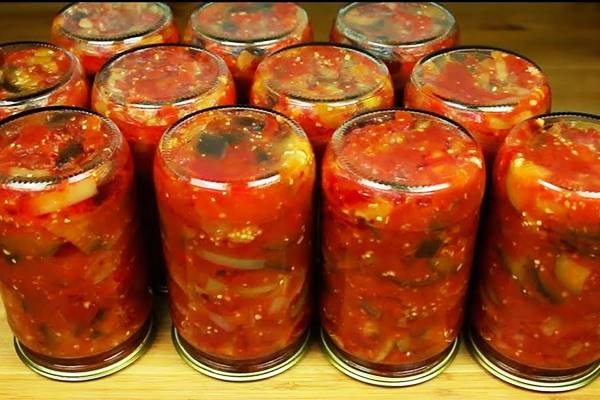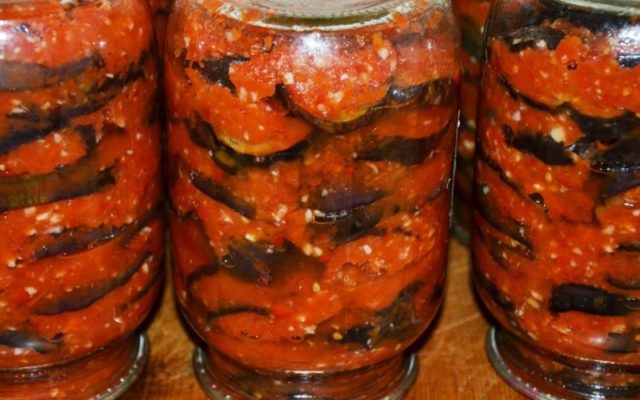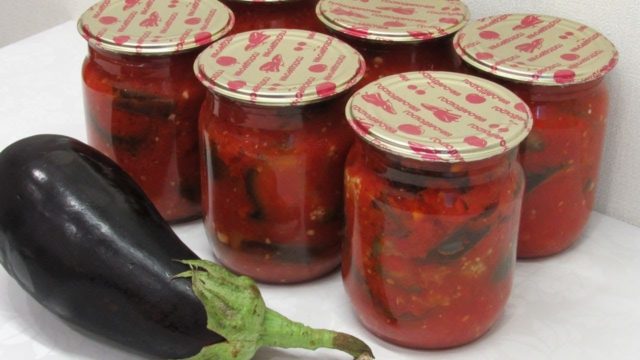Content
- 1 Rules for cooking eggplant in Bulgarian for the winter
- 2 The classic Bulgarian eggplant recipe
- 3 Bulgarian eggplants for the winter without sterilization
- 4 Bulgarian eggplants with herbs and garlic for the winter
- 5 Spicy Bulgarian eggplant with hot pepper
- 6 Bulgarian eggplant lutenitsa for the winter
- 7 Storage rules
- 8 Conclusion
Bulgarian eggplant for the winter is an excellent vegetable snack, which is usually harvested for future use in late summer or early autumn. This popular canned salad is based on a recipe for lecho - a classic Hungarian dish made from sweet peppers stewed with tomatoes and onions. Such an appetizer has long been honored by the neighbors of the Hungarians, Bulgarians, but the latter traditionally prepare this dish, diversifying it with another key component - eggplant.
There are many variations on the Bulgarian eggplant theme. The main ingredient is cut into circles, cubes or even baked, then kneading into a homogeneous mass, then mixed with the rest of the vegetables or layered with tomato-onion sauce, adding greens, chili, garlic. The bottom line with any of these recipes is a great winter salad that's rich, vibrant, and extremely mouth-watering.
Rules for cooking eggplant in Bulgarian for the winter
No matter what Bulgarian eggplant recipe the hostess chooses, it is very important to take the ingredients responsibly:
- eggplants should be large, fleshy, with an evenly colored, dark, shiny skin, without flaws and rotting places;
- it is better to prefer juicy and ripe tomatoes, perhaps even a little overripe;
- ideally, if the bell pepper is red: in this case, the color of the finished salad will turn out to be the most appetizing.

Eggplants for Bulgarian-style preparations should be selected ripe, fleshy and without visible flaws
It often happens that the eggplant pulp is very bitter. To eliminate this unpleasant effect, it is advisable to immerse whole washed fruits in salted water for half an hour before slicing and press down on top with a load, preventing them from floating up. Then the vegetables need to be washed in clean water and then proceed in accordance with the recipe.
The classic Bulgarian eggplant recipe
The classic Bulgarian tradition of cooking eggplants with vegetables for the winter is the thick Manjo salad. Its feature is the simultaneous stewing of all ingredients, and an additional advantage is that the cans with the blank do not need to be sterilized.
Ingredients:
Eggplant | 2 Kg |
Bell pepper | 2 Kg |
Tomatoes | 3 Kg |
Carrot | 0.3KG |
Bow | 1 kg |
Garlic (head) | 1 PC. |
Salt | 100 g |
Sugar | 100 g |
Vegetable oil | 200 g |
Vinegar (9%) | 0.5 tbsp. |
Black pepper (ground) | 0.5 tsp |
Chile (optional) | 1/5 pod |
Preparation:
- Rinse the eggplants well. Cut off the ponytails on both sides, cut into circles approximately 1.5 cm thick.
- Peel the bell peppers and onions. Cut into small strips.
- Scald the tomatoes with boiling water and peel them. Purée with a blender or meat grinder.
- Chop the peeled carrots, cloves of garlic and a slice of hot pepper in mashed potatoes.
- Place all vegetables in a large saucepan. Add salt, sugar, vegetable oil, black pepper, vinegar.
- Put the saucepan on the stove and, bringing the salad to a boil, simmer over low heat for 40 minutes.
- Fill prepared sterile 0.5-1 liter jars with hot snacks. Roll up with boiled lids, turn upside down and, wrapped, leave to cool completely.

Traditional Bulgarian preparation for the winter, "Manjo" salad with eggplant, tomato and sweet pepper, will please even gourmets
Ripe, thick-skinned vegetables are best cooked in Bulgarian without the skin.
The process of making the Bulgarian Manjo salad is illustrated in detail by the video recipe: https://youtu.be/79zwFJk8DEk
Bulgarian eggplants for the winter without sterilization
Lovers of canning vegetable snacks are often frightened by the need to additionally sterilize containers with blanks in a boiling water bath. Nevertheless, Bulgarian style eggplant lecho can be prepared without this laborious and difficult procedure.
Ingredients
Eggplant | 1.5KG |
Bell pepper | 1 kg |
Tomatoes | 1 kg |
Carrot | 0.5KG |
Bow | 0.5KG |
Garlic | 3-4 cloves |
Sugar | 0.5 tbsp. |
Salt | 2 tbsp. l. |
Vegetable oil | 0.5 tbsp. |
Vinegar (9%) | 120 ml |
Pepper (black, allspice) | To taste (3-5 pcs.) |
Laurel leaf | 2-3 pcs. |
Preparation:
- Rinse the eggplants, remove the tails and cut into 1-1.5 cm thick bars.
- Chop the peeled carrots into thin circles (4-5 mm).
- Remove seeds from bell pepper and cut the pulp into medium-sized strips.
- Peel the onion. Cut into half rings.
- Divide the tomatoes into 4-6 slices and mince.
- Put carrots on the bottom of a cast iron or a saucepan with thick walls. Pour in tomato puree and vegetable oil, mix.
- Bring to a boil and simmer over low heat for about half an hour.
- Add the onion and bell pepper to the saucepan. Stir gently and wait until the mixture boils.
- Pour in pieces of eggplant. Season with salt, sugar, spices. Stir and, after boiling, cook the workpiece for another half hour, without covering it with a lid.
- 5 minutes before turning off the heat, add pressed garlic, bay leaf and vinegar to the pan. Mix.
- Arrange the hot Bulgarian-style lecho in half-liter jars, previously sterilized. Seal hermetically with lids soaked in boiling water for a couple of minutes. Turn upside down, carefully wrap with a thick cloth and leave for about a day.

Bulgarian lecho for the winter is prepared with eggplants and does not require additional sterilization
Bulgarian eggplants with herbs and garlic for the winter
Among the best recipes for Bulgarian eggplants for the winter are multi-layered canned food, in which the main ingredient, cut into appetizing circles, alternates with thick "minced meat" from fried onions, fleshy tomatoes, spicy garlic puree and finely chopped fresh herbs.
Ingredients:
Eggplant | 1.2KG |
Tomatoes | 0,4 kg |
Bow | 0.3KG |
Garlic | 1-2 slices |
Parsley | 1 small bundle |
Salt | 30 g + 120 g (for brine) |
Vegetable oil | 120 g |
Black pepper | Taste |
Preparation:
- Wash the eggplants thoroughly, cut off the ends. Cut into thick washers (1, -2 cm).
- Place the mugs in a concentrated sodium chloride solution (120 g per 1 L of water) for 5 minutes.
- Discard in a colander, wait for excess water to drain, and fry in hot vegetable oil on both sides until golden brown.
- Chop the peeled onion into thin slices. Fry evenly until golden brown.
- Remove the stalks from tomatoes, cut them into slices for convenience and puree with a meat grinder. Heat the resulting mass to a boil on the stove and rub through a sieve (you can use a blender), then boil it to half the volume.
- Peel and crush the garlic with a press.
- Rinse greens and chop finely.
- Mix onion, garlic and herbs with tomato paste. Season with salt, pepper, stir and heat until boiling.
- Warm slightly cleanly washed dry half-liter jars. Put a small layer of tomato and onion mass on the bottom, then circles of fried eggplants. Repeat layers until the jar is full (the top layer should be tomato).
- Cover the cans with boiled tin lids. Place in a wide container with warm water and, bringing it to a boil, sterilize for 50 minutes, then roll up.

Bulgarian eggplants can also be cooked in the form of washers, layered with tomato sauce with herbs, onions and garlic
Spicy Bulgarian eggplant with hot pepper
Spicy Bulgarian eggplants with the addition of chili can be cooked without frying, but baking vegetables in the oven. In this case, the dish will be more useful, and the oil consumption will be less.
Ingredients:
Eggplant | 3 Kg |
Tomatoes | 1.25KG |
Bow | 1 kg |
Garlic | 0.1kg |
Chile | 1 pod |
Greens (parsley, dill) | 1.5-2 bundles |
Salt | 1 tbsp. l. + 120 g (for brine) |
Pepper (black, allspice) | 0.5 tbsp. l. |
Vegetable oil | 75 g |
Preparation:
- Cut the washed eggplants, from which both "tails" have been removed, into thick circles (2 cm each).
- Prepare a salt solution as in the previous recipe. Place eggplant washers in it for 20-30 minutes. Then squeeze out slightly, put in a deep bowl, pour in 50 g of vegetable oil and mix.
- Place in a single layer on a non-stick baking sheet and bake in the oven until golden brown (about 7 minutes on each side).
- Fry the onions in the remaining vegetable oil for about 20 minutes, making sure not to burn.
- Use a blender to puree the tomatoes, garlic cloves and peeled chili. Pour in salt, sugar, ground pepper. Boil the sauce for half an hour, then add fried onions and finely chopped fresh herbs to it. To stir thoroughly.
- In pre-sterilized 0.5-liter jars, lay out layers of tomato sauce and eggplant slices, making sure that the top layer is the sauce.
- Cover the baking sheet with paper napkins. Put jars of Bulgarian eggplant on it, cover them with lids. Place in a cold oven, pouring a small amount of water into the bottom of the baking sheet. Set the temperature regime to 100-110 ° C and sterilize the canned food for an hour.
- Cork the jars hermetically, turn over, wrap and allow to cool.

Eggplant circles for canning for the winter according to the Bulgarian recipe can be pre-fryed, but baked in the oven
Advice! If the oven is equipped with a grill, it is worth using it at the stage of baking the eggplants in Bulgarian, then they will be ready faster.
Bulgarian eggplant lutenitsa for the winter
Lyutenitsa is a thick, scalding, hot sauce for the winter in Bulgarian style from baked eggplants “without a skin” and sweet peppers, boiled in thick tomato puree with chili and garlic.
Ingredients:
Eggplant | 1 kg |
Sweet pepper | 2 Kg |
Tomatoes | 3 Kg |
Garlic | 0.2KG |
Chile | 3-4 pods |
Salt | 2 tbsp. l. |
Sugar | 150 g |
Vinegar | 0.1 l |
Vegetable oil | 0.2 l |
Preparation:
- Remove the stalks from washed eggplants. Cut vegetables lengthwise into 2 halves and bake in the oven for half an hour.
- Gently remove the peel from the cooled fruits, and grind the pulp in mashed potatoes using a blender.
- Put the washed bell pepper whole on a baking sheet and bake in the oven for 20 minutes. Then put the fruits in a bowl, tighten with cling film and leave for 10 minutes. After that, remove the top skin from them and remove the seeds, and puree the pulp with a blender.
- Blanch the tomatoes in boiling water for a couple of minutes, then peel and grind until smooth. Pour the tomato puree into a stainless steel container, put on fire and, allowing it to boil, boil for about half an hour.
- Grind peeled garlic cloves and chili pods without stalks and seeds in a blender bowl.
- Add eggplant and bell pepper puree to the tomato saucepan. Let the mixture boil. Add salt, sugar, ground chili and garlic and boil for another 10 minutes.
- Turn off heat and pour vinegar into sauce. Mix.
- Place the workpiece in clean, dry 0.5-liter jars. Cover them with lids and sterilize in a water bath for 15 minutes. Roll up and leave to cool completely.

Burning thick lutenitsa sauce will surely delight lovers of spicy dishes
Storage rules
It is recommended to store canned food with Bulgarian eggplants, which have been sterilized, in a dark place, possibly at room temperature. The period during which they should be consumed is 1-2 years. Canned vegetable salads, closed without sterilization, are stored for no more than a year.
Conclusion
Bulgarian eggplants for the winter can be cooked in different ways: in the form of lecho, classic "Manjo" salad, hot lutenitsa sauce, snacks made of whole circles in tomato and vegetable puree. Any of these canned dishes will be an excellent addition to the second or side dish, diversifying the festive and everyday menu. It is definitely worth a little work at the height of the vegetable season so that the Bulgarian eggplants served at the dinner table in winter are a pleasure for the whole family.








